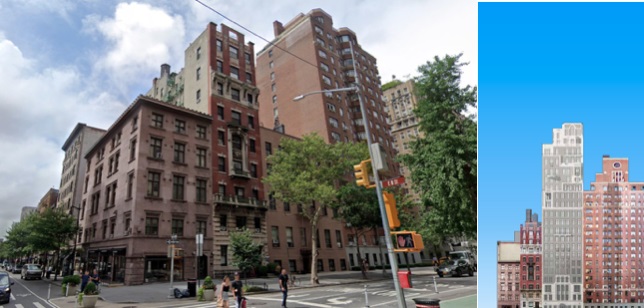Bret Harte and 14-16 Fifth Avenue
On May 11th, 2021, the NYC Landmarks Preservation Commission, in a highly unusual split decision, voted to approve the demolition of the historic, landmarked 170+-year-old building at 14-16 Fifth Avenue and replace it with a 213-ft-tall tower. While we were deeply disappointed by and adamantly opposed the Commission’s decision, we were glad that our advocacy and that of thousands of others who participated in support of the campaign led to a 42% reduction in the height of the approved tower, originally proposed to be 367 feet tall.
Over the several years prior to this fateful decision, the Village Preservation research team clearly established the historic significance of this building, which was originally constructed as two separate houses in 1848 by the Brevoort family, one of New York’s oldest and most prominent families. When first built, the houses led the transformation of Lower Fifth Avenue into the most prestigious address in New York City.

One such resident who contributed to the historic significance of the building was author Bret Harte. Not to be confused with 32-time champion and two-time- WWE Hall of Fame inductee wrestler Bret “The Hitman” Hart, Harte was an acclaimed American author and poet in the second half of the 20th century. In a career spanning more than four decades, Harte wrote poetry, plays, lectures, book reviews, editorials, and magazine sketches, although he is best known for his short fiction works featuring miners, gamblers, and other figures of the California Gold Rush.
Born in Albany on August 25, 1836, to Jewish immigrant merchants, Harte moved to California at age 17 where he found work as a miner, teacher, messenger, and journalist.

Harte gained local infamy for reporting the February 26, 1860, massacre of Native American Wiyot people (mostly women and children) at the village of Tuluwat while serving as assistant editor of the Northern Californian. At that time, California’s “Act for the Government and Protection of Indians” was part of the state-sponsored genocide that removed Native Americans from their lands, separated children and adults from their families, languages and culture, and created a system of indentured servitude as punishment for minor crimes. Harte’s detailed editorial described the massacre in detail: “[A] more shocking and revolting spectacle never was exhibited to the eyes of a Christian and civilized people. Old women wrinkled and decrepit lay weltering in blood, their brains dashed out and dabbled with their long grey hair. Infants scarcely a span long, with their faces cloven with hatchets and their bodies ghastly with wounds.”
Following this publication, Harte’s life was threatened and he was forced to quit his job and moved to San Francisco.

Through the 1860s Harte published short stories and poems in various magazines and journals in California, many of which were also widely available in the east. He became more famous in the east after his poem known as “The Heathen Chinee” was republished in a number of newspaper in 1871 including the New York Evening Post, the New York Tribune, the Boston Evening Transcript, the Providence Journal, the Hartford Courant, Prairie Farmer, and the Saturday Evening Post. That poem satirized the pervasive anti-Chinese sentiments of the time, but was taken literally by some readers and seen as an affirmation of their prejudices.
Harte lived at 16 Fifth Avenue in 1871 at a seminal time in his life, as he transitioned from the west coast to the east and later to Europe. As he made this transition, he incorporated new subjects and characters into his stories, but his Gold Rush tales have been those most often reprinted, adapted, and admired.
According to Esme E. Berg, the Executive Director of the New Amsterdam History Center: “The year 1871 was a critical one in the career of Harte. He was welcomed to New York and New England by the promise of fame and wealth, and signed what had been recorded as the most lucrative contract in American letters at that time. Paid ten thousand dollars to write all the fiction and poetry he could in a year for the Atlantic Monthly, Harte became the highest earning and most widely followed writer in America. Needless to say, Harte’s stay at 16 Fifth Avenue was an essential part of his physical and professional journey during the height of his fame.”

Many of Harte’s works were later translated into different languages such as German, French, Italian, Swedish, and Russian and in 1877, Harte collaborated with Mark Twain on the play Ah Sin. Twain and Harte were friends but around 1878 had a substantial falling out, and Twain had some choice words to say about Harte following his death, criticizing him both personally and professionally. Harte died in England at age 65 on May 5, 1902.
The decision to allow the demolition of this historic building was incredibly disappointing given its important history and the outpouring of support for saving the building from thousands of New Yorkers, prominent scholars and writers, and elected officials including Council Speaker Corey Johnson, Borough President Gale Brewer, State Senator Brad Hoylman, and Assemblymember Deborah Glick.
We’re deeply grateful for the support to preserve the building from the five of eleven members of the LPC who passionately opposed demolition.
We are also proud that our collective efforts resulted in several substantial reductions in the oversized height of the building, from the original 367 ft to the final 213 ft — a 42% decrease. But there can be no excusing the LPC’s decision to approve the erasure of history, as well as the demolition of 20 units of housing for longtime residents, half of which were affordable rent-regulated units, to be replaced by a high-rise pied-a-terre for the super-rich with fewer units of housing than the modest but historic building that will be replaced by a developer with a less-than-stellar track record.
